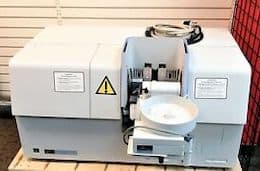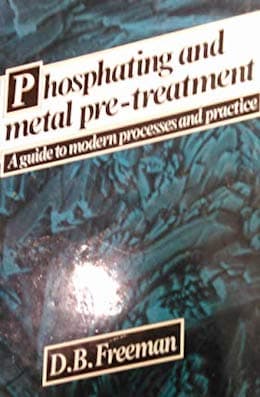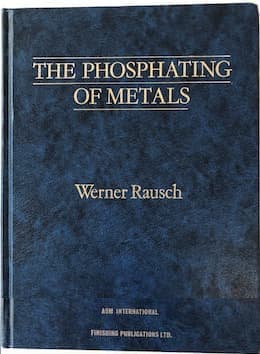
Curated with aloha by
Ted Mooney, P.E. RET

The authoritative public forum
for Metal Finishing 1989-2025

-----
Wastewater treatment of iron and zinc phosphate conversion coating processes
Q. I am searching for information concerning treatment of wastewater from a zinc phosphate conversion coating process. My contact is considering changing to zinc phosphate from iron phosphate.
Kirk K [surname deleted due to age of posting]- Huntsville, Alabama
1999
by Clarence Roy
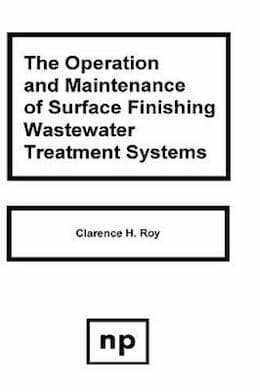
on AbeBooks
or eBay or
Amazon
(affil links)
A. It's not hard to treat that type of water.
The rinse from the phosphating bath will have a pH of something like 5.5 - you need to adjust it to about 9, then add an anionic flocculant solution. Use sodium hydroxide - lime or mag hydroxide would likely add a lot to your sludge volume because of the phosphate. There should also be a large pH adjustment mix tank so that this buffered waste has a chance to equalize. Depending on conditions, your Zn residual will vary from 1 - 5 ppm.
If you need to do better than that, it may help to add some sodium sulfide, ferrous sulfide slurry, or DTC to the mixture after the pH adjust, but before the floc add.
Good luck.

Dave Wichern
Consultant - The Bronx, New York
Q. I own and operate an electrocoating plant and have waste treatment problems.
1. Our process uses a zinc phosphate stage as part of the pretreatment for the e-coat. Our waste water permit allows us to discharge a monthly average of 1.0 mg/Liter and a peak discharge (daily limit) of 2.6 mg/Liter. Our normal stream concentration is about 20-30 mg/Liter. I need an economical way to remove the zinc. I have a filter press, settling tower and several 2000 gallon poly tanks to use for storage. I have tried to precipitate out the zinc using a flocculating agent and raising then lowering the pH but when I send it through the filter press it clogs it up and also lets a lot of particles through the screens, and thus to drain.
2. Also, I am in need of an accurate and repeatable way to measure the zinc levels of our waste stream. Someone told me of some type of Atomic spectro something or other. Does anyone have any ideas on this? I have tried a colorimeter made by Hach Co. and it does not give accurate readings (as compared to the water department monitoring our discharge).
Thank you
- Washington, Michigan
2000
A. Rodger, your supplier of the proprietary zinc phosphate should be available to help you waste treat the waste stream. The vendor should be a full service company with waste treatment chemicals and experienced sales/technical service, including a laboratory.
Bill HempTech Svc. w/ chemical supplier - Grand Rapids, Michigan
A. Dear Roger,
1. I assume you are already treating with hydrated lime
[affil links] which facilitates wonderful settling.
2. I am not too sure how sophisticated your laboratory is, but if you a need simple test for small quantities of zinc: we use the "Aquaquant" test from a company called Merck.
Good luck
Trudy
- Durban, South Africa
A. Zinc phosphate, by itself, gives a very slimy sludge. You might want to look at using some magnesium hydroxide to precipitate it. This stuff is itself rather insoluble so is irritating to work with. Try reacting it with the acid to get some in the system and then finish off with lime or other caustic.
James Watts- Navarre, Florida
A. Hi Rodger, let me throw some light upon the second part of your query.
I have a pretty good handle on an Atomic absorption unit or an (AA Unit)
⇦ this on
eBay
or
Amazon [affil links] .
This is a fine piece of accurate equipment which uses air and acetylene (or even nitrous oxide) and the sample of waste water is aspirated into this flame. The flame changes colour depending upon the concentration of the metal in it and this absorbency is decoded in the metal concentration present in the sample.
This is just a simple idea but the AA Unit is certainly a very reliable technique to detect any metal.
You use some hollow cathode lamps of the same metal (which is to be detected). Once you set up all calibration steps it takes you 5 seconds to detect a sample with 95% accuracy for sure. And you may proceed with any number of samples after calibration. So it is very fast too.
Ask your nearest Varian dealer. You may find a good deal in some used equipment (say maybe $5,000 USD).
Regards

Hemant Kumar
- Florida, USA
A. Magnesium hydroxide is indeed a great precipitant, but it is a slurry of particles not a solution, and therefore the reaction time can run 6 hours and even more as the particles dissolve ever so slowly into the acidic waste.
Hemant tells you true. While I like the economy and simplicity of Hach type tests and colorimeters, your results are not atypical: the best you can usually expect from a relatively quick colorimeter test in a dilute mixed metal jobshop waste stream (because of so very many possible interferences) is a correlation factor. I.e., if you read 1.3 ppm in your lab when the sewer authority gets 2.6 using AA, it's a fair bet that if you get 2.0 next time, they'll get about 4.0. The relationship often correlates enough to at least tell you when things are safe or going south :-)

Ted Mooney, P.E.
Striving to live Aloha
finishing.com - Pine Beach, New Jersey
2000
A. Perkin Elmer has a good model for Atomic Absorption. It's the AAnalyst 100. That's the one I personally run at work and I am within 0.1 ppm of what an independent lab runs our waste water at.
Vicki Harwood- Wyoming, Michigan, USA
2002
A. We also use an AA machine to detect the cadmium levels in the waste water. I would suggest to filter the solution before running it. Let the flame burn for five minutes after the test to clear the orifice.
Soda ash will cut the metals; floc will help the metal settle in solution. You will still need another chemical as a negative charge.
Dale Maymining - Bartlesville, Oklahoma
2004
A. Dear sir,
I read about the problem you are having with your Zinc lines. I have read the other responses and I must say, some of those things I read made no sense to me.
Atomic Absorption or called Atomic Spectrophotometry is definitely an advantage, but for a simple process, it's overkill not to mention cost. A colorimeter or reagent test kit would suffice. I understand that you have tried a Hach test kit but were unable to achieve accurate results, I was curious as to why it wasn't working. I have used AA, Ultra-violet spectro, gas spectro and colorimeters; all of which were very accurate.
I could easily suggest some remedies that might solve your problem but would be wrong in doing so just for the simple fact, that to my ears there is too much missing information which can be vital in making any decision.
Anyone that has been involved in industrial chemistry should know this. I would be glad to help you in any way I can.
But first I need to know the following:
2. What type of processor operation are you supporting?
3. What is your rate of production?
4. How is your plating line set up? Concentration levels, rinse types, etc.
5. How many and what type of cleaners are you using?
6. How often do you dump and remake tanks?
7. What does your W.T. setup consist of?
7. What is your rate of discharge in waste treatment?
8. What are you using to control pH and what are the optimum pH levels you are using.
9. How knowledgeable are your technicians?
10. What is the climate like where you are at?
As I mentioned earlier, I would be happy to help. But all these questions I ask can mean everything ... why? Because that's chemistry for ya!
Currently I oversee a zinc phosphate line and waste treatment and to be honest with you we haven't had any problems at all.
I hope by now you have found a solution to your problem.
Eric F [surname deleted due to age of posting]
- Sanford, North Carolina
----
Ed. note: If you feel that some of the other responses "made no sense", Eric, please try to be specific because not doing so undercuts every other posting :-)
Thanks.
Q. I am from University of North Carolina at Charlotte, and working for a small metal finishing company with a waste water flow of 62000 gallons/month. This company has an Iron Phosphate system and tumbling, deburring, and Punch Press unit. A few months back they start noticing an elevated level of Zinc in their waste water. We have a speculation that this might be from the Mill Oil they are clearing during these processes but did not now the exact relationship. The Facility also has had higher BOD level during the same weekly testing period. Could someone explain any correlation between oil & grease, Zinc and BOD. Thanks you very Much.
Thanks,
UNC - Charlotte - Charlotte, North Carolina
2003
by Kushner & Kushner
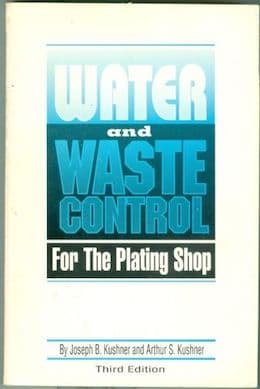
UTL on eBay
UTL on AbeBooks
on Amazon
(affil links)
A. Hi, Kshitiz. I think what you might best do is to track down the various effluent pipes that are feeding the waste water treatment system, and see what pipe the zinc is coming in from. Then you have to continue to work backward until you find it. Guessing where the zinc is coming from is just speculation. It could be the oil, the reagent chemicals, or a stripping operation--but it could be other things. Sorry. Good luck!

Ted Mooney, P.E.
Striving to live Aloha
finishing.com - Pine Beach, New Jersey
2003
A. When a waste effluent characteristic changes it is usually because of a change in the waste presented to the system. Deburring and cleaning chemical suppliers are famous for providing heavy loads of sequestering agents (chelators) in their formulations because they work so well. Check upstream, and you will probably find EDTA or some such chelator is present. Then work on your supplier to eliminate it.

Paul Morkovsky
- Shiner, Texas, USA
2003
Q. We use phosphoric acid to remove flash rust of steel parts prior to the barrel zinc phosphate process. We have some difficulty removing the total phosphorous from our discharge into a POTW. Can someone help us on this issue?
Thanks,
- Red Lion, Pennsylvania, USA
2003
A. Adding Calcium (such as from hydrated lime [affil links] or Calcium Chloride Solution) to your wastewater stream will precipitate most of the Phosphates, thus removing them from your filtered or clarified effluent - but adding Calcium Phosphate to your solid waste stream. The amount required will depend not only upon the pounds per day of phosphate currently going to the Sanitary District, but also on the amounts of other cations which are insoluble with Calcium. The most common of these is sulphate, you might want to consider switching a Sulfuric pickle to Hydrochloric to avoid generating excess sludge.
Craig Haseltine- St Charles, Illinois, USA
A. Depending on what your doing, how much water you are using, and the parts you are working with, you might find that a closed loop system will give you better control over effluent - essentially by not discharging with exception of batch treatment of regenerants, which gives you complete control over the discharge BEFORE it happens by testing. Also, you could perhaps look at acid recovery for the phosphoric bath, and return the rinses back to the bath for make-up. This eliminates the build up of contaminants and also allows you to close that loop as well. You essentially do not have to dump the bath, which would eliminate a source of phosphorus in your effluent streams.

Tom Baker
wastewater treatment specialist - Warminster, Pennsylvania
A. You can try the ferric chloride ⇦ this on eBay or Amazon [affil links] to precipitate it
Jack, Cui- Singapore
Q. Can anyone help me find out about the safety issues with Iron Phosphatizing and any wastewater issues. Are there any articles out there that discusses these issues. I need as much info as I can get.
Rosy DeSimoneEmployee - Kansas City, Missouri, USA
2007
A. Iron phosphating is a Federal categorical process, with defined pretreatment discharge limits. The most likely contaminant in spent rinse water is zinc, if you are applying this coating on galvanized steel. An adjustment of the pH to 9 - 9.5, followed by the addition of flocculant, and settling, should leave the residual Zn in the decant below this limit. (monthly average = 1.48 mg/l; daily max = 2.61 mg/l)
Your local POTW may have restrictions on the discharge of iron and/or phosphorus. Get with them and see what their policy is.
Both the settled sludge from this operation, and the tank bottoms, are categorical hazardous wastes. They need to be dewatered, and hauled to a haz waste landfill.

Dave Wichern
Consultant - The Bronx, New York
A. Phosphatizing is a listed process in Section 433 of EPA regulations for the Metal Finishing Category. However, if you are doing iron phosphatizing and not zinc phosphatizing, you may not have any worries, since iron discharges are not regulated in these regulations. However, as the previous responder noted, zinc and nickel (a common ingredient in zinc phosphate coating solutions) are regulated.
Most iron phosphate operations that I know of have no waste treatment other than possibly neutralization. These operations often haul any concentrated dumps off-site for treatment and disposal.
Even if there are no Federal Regulations that apply to your situation, you would still need to meet the requirements of your local sewer use code. Many local codes allow up to 50 mg/L or more of iron, and allow a fairly high concentrate of phosphates before any surcharge would be levied. So, if you are just doing iron phosphate coating, I suggest that you contact your local sewer authority for advice.
consultant - Cleveland Heights, Ohio
2007
A. I would ask a consulting firm to look into this, and should quickly determine the point of the introduction of Zinc. There are strict EPA regulations when discharging Zinc into the effluent. Our plant has a complete waste water system to floc and add product to the water prior to discharge to the city wastewater plant. Most are not equipped or prepared for Zinc.
Our local water company has a pull meter at the manhole just prior to leaving our property. In addition, all of our tests, titrations, etc., are kept on file. The City then sends these samples to an independent lab for analysis.
I prefer the wastewater treatment, to allow our system to Zinc Phosphate for pre-treatment of various coatings to AL and metals for superior finishes.
Trison Coatings inc. - Lewisburg, Tennessee, USA
December 27, 2017
Q. I have a comment on phosphate: Where can I get more information on phosphate and where can I get the permit to allow increase of phosphate? But my question is whether phosphate tank will push our ppm past our allotted approval rating?
Israel Rodriguez- Houston, Texas
July 20, 2018
A. Hi Israel. If you are discharging to a sewer/POTW rather than direct to a river, the POTW is usually authorized and required by the EPA to administer the permit program for industrial discharges. But what limits you have may depend upon what industry sector you are in.
If you are unsure of your status, but are responsible for it, you probably should hire an environmental consultant because there can be lot to it. Best of luck.
Regards,

Ted Mooney, P.E. RET
Striving to live Aloha
finishing.com - Pine Beach, New Jersey
July 2018
Q, A, or Comment on THIS thread -or- Start a NEW Thread
